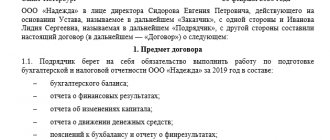The transfer of cash from one person to another must be accompanied by the preparation of a special receipt. Most often, this document is used in relations between individuals, but sometimes it can also be used between ordinary citizens and organizations (for example, when it comes to banks or microfinance companies).
- Form and sample
- Free download
- Online viewing
- Expert tested
FILES
Why do you need a receipt?
A receipt is a document that confirms that money was transferred from one individual or legal entity to another person as a loan or for other reasons.
The receipt contains information about how much money was given, under what conditions, and in what period it should be returned to the lender.
In cases where disagreements arise between the creditor and the debtor and one of them decides to go to court, it is the receipt that becomes the official document that proves the fact of the transfer of money, and also shows the conditions for their use and the time frame within which they should have been received given back.
A receipt is not one of the mandatory documents that must accompany the transfer of cash (by the way, in relations between citizens there are no such documents at all), but it is recommended.
What is the legal force?
Let's consider whether the receipt has legal force. Absolutely yes. It confirms the fact of transfer of funds or other property.
However, in order to collect the amount of debt through the court, it is necessary that the document contains the basic conditions. The court will refuse to satisfy the claim if the document does not contain the parties’ data, the date of execution, the amount of debt or the original signature.
Important! The only way to collect a debt on a receipt is through court.
Sometimes citizens turn to the police department with a document. However, the police do not resolve civil disputes.
Therefore, it is necessary to go to court at the place of registration of the debtor.
Depending on the amount of debt, you must contact:
- up to 50,000 rub. - magistrate's Court;
- from 50,000 rub. - district court.
When is the document most often used?
There are many reasons for creating a receipt for receiving funds:
- purchase and sale of goods;
- payment for services or rent;
- simple debt, etc.
It should be noted that in a situation where we are talking about a debt obligation, the parties sometimes enter into a loan agreement between themselves - it is more serious from the point of view of the law, because contains more complete and detailed information, but must be drawn up according to a certain scheme and structure, while a receipt is simpler in terms of design and at the same time has almost equal legal force (provided, of course, that it contains some mandatory information).
Requirements for a receipt for the transfer of money
Let's consider 5 mandatory requirements for a promissory note:
- It is necessary to indicate the place of its preparation (the locality where the money is transferred).
- Write down the name of the document being drawn up - Debt Receipt or Cash Receipt
- The full last name, first name and patronymic of the person borrowing money and the person lending it must be indicated. The borrower must provide data without abbreviations, as in the passport. You can also provide the full passport details of the parties.
- Indicate the loan amount (the specific amount that is transferred from hand to hand is indicated in rubles and kopecks; it is better to duplicate the digital data in written text).
- The date when the money was received is indicated (the date is indicated in full, that is, day, month, year).
- At the end of the receipt, the signature of the borrower is required (the signature must be written in full, correspond to the full signature of the borrower under normal conditions. If the document is printed on a computer, it will be correct if the borrower at the end of the receipt handwrites his last name, first name and patronymic without abbreviations and signs) .
There are 2 additional requirements for the receipt, which are indicated at the request of the parties:
- The period when the borrower will return the money (repayment of the debt can be in parts or the entire amount). The date may be specified specifically as “DD-MM-YYYY” - this will be the correct option to avoid confusion, or a specified period of time. If the parties do not indicate the date on the cash receipt, the refund will be made 30 days after the creditor makes such a claim.
- The amount of interest for using money (usually the amount of interest is indicated for a month, but it is allowed to indicate interest for any period) and the amount of interest (fine) for violating the terms of repayment of the loan (usually the amount of interest is indicated for each day of delay).
Do I need to get it certified by a notary?
The obligation to certify a receipt by a notary is not stipulated in the legislation of the Russian Federation, i.e. Each lender has the right to decide for himself whether he is interested in having the receipt certified by the signature of an employee of a notary office or not.
However, the very fact of having a notary’s autograph gives the receipt greater significance, so you should not neglect it.
The only minus here, or rather, even two – time costs and additional financial expenses.
Download the loan agreement between individuals
Before downloading a loan agreement, competent lawyers warn that all conditions of its execution (sections) and their compliance with the conditions must be checked:
- interest-free or interest-bearing loan (the moment of interest repayment is indicated: at the end of the term or they are included in payments during the term of the agreement);
- type of loan (targeted or non-targeted);
- method of receiving and returning funds (cash, bank transfer, other);
- time of receipt and return of funds (in parts, in a single amount, in tranches);
- liability of the parties, provision, return, grounds for termination (each condition is agreed upon by the parties or regulated by current legislation);
- use of the claims procedure for pre-trial settlement;
- places for consideration of claims (by law or by agreement of the parties).
Advice to Sravni.ru: Do not waste time drawing up a loan agreement with a notary or with witnesses. Prepare the required number of copies - according to the number of interested parties: this is enough for the official consideration of the document in controversial cases.
Why are witnesses needed?
Some lenders prudently enlist the support of witnesses when transferring money. They may be uninterested persons, information about whom is also required to be included in the receipt (their full name, passport details and address of residence).
With their signatures, they confirm the fact that the money was transferred exactly in the amount stated in the receipt and on the conditions indicated in it.
In fact, in some way the witnesses perform the function of a notary.
Errors when drawing up a document
Making a receipt for receiving funds is quite simple. Many citizens use ready-made document samples. However, not all samples provided on the Internet exactly correspond to the legal requirements for drawing up a loan agreement. Most of the participants in the transaction make mistakes, which in the future may cause the borrower to fail to repay the debt.
Errors that affect the legitimacy of a document include:
- Inaccurate or incomplete data of the parties to the transaction.
- The loan amount is not written in block letters.
- There is no exact deadline for repayment of borrowed funds.
- Presence of blots and errors in personal data.
Unfortunately, the legal side of issuing a receipt is only the tip of the iceberg. Few people pay attention to the ethical and moral side of the process of fulfilling the terms of the contract.
Transferring the loan amount to the bank account of a relative of the lender is the most common mistake of the borrower. The text of the receipt should always indicate the bank details to which transfers will be made to repay the debt (only relevant in case of non-cash payments). If the lender asks the borrower to transfer money to an account that is not related to previous agreements, you should not comply with his requests - in most cases this is fraud.
Lenders unwittingly make a mistake that casts doubt on the fact of further debt collection from the borrower in court. Paragraph 1 of Article 807 of the Civil Code of the Russian Federation states that the loan agreement is considered concluded from the moment the money is transferred. This means that if, during a non-cash transfer of funds, the lender does not indicate the purpose of payment, the loan agreement may be considered not concluded.
You should not take the borrower’s word for it; always check his passport details, because they are his personal identifier.
Rules for drawing up receipts
This document is formed in simple written form in any form on a regular sheet of paper. It is also possible to print the receipt on a computer, but this option is not considered the best, since if there is a need for a graphological or handwriting examination, such a receipt will not be the most convenient object of study.
The text must indicate:
- date and place of document formation;
- last name, first name and patronymic of the person who takes the money, his passport details, address of residence (official and actual). Similarly, the receipt contains information about who gives the money;
- amount - it must be indicated in numbers and words;
- if cash is transferred in foreign currency, we advise you to indicate its current exchange rate and the amount in which the debt will need to be repaid;
- deadline for refund;
- return method: cash or by bank transfer - to a card or bank account) and return method - lump sum or in installments. If the second option is chosen, you need to draw up a detailed payment schedule;
- in the case where money was given, what is called “at interest,” this must also be indicated in the document (and the amount of the interest rate must be specified).
Finally, the receipt must be certified by the signature of the person who accepts the money (it is desirable that the signature matches the one in his passport) and the autographs of witnesses, if any, during the money transfer procedure. If desired, the lender can also sign the document.
The receipt is drawn up in a single copy and handed over to the lender.
How to repay a debt using a receipt
The process of collecting a debt from an individual against a receipt has its own peculiarities. It is important to know when and how a person can claim their rights.
When can you demand money?
According to current legislation, the creditor has the right to sue the debtor from the moment of violation of debt obligations. Depending on what conditions are specified in the receipt, the requirement appears:
- from the day following the date of return of the full amount;
- from the day following the date of repayment of half of the loan, if there is an agreement between the parties to pay in installments;
- after the borrower refused to repay the debt within a reasonable time, when the receipt does not indicate the exact date of repayment.
The last point is a special case. If, at the time of drawing up the document, the parties have not agreed on the exact date when the debtor is obliged to return the money, the transaction is considered to be concluded for an indefinite time. In practice, the lender must first send a request for repayment to the borrower in writing, and then take more radical actions within a reasonable period of time (in the most common practice, this is about 30 days).
Pre-trial settlement, filing of formal claims
If the debtor categorically refuses to fulfill his obligations, lawyers who work to collect debts by receipt recommend not wasting time and immediately filing papers with the court.
In other cases, you can try to resort to pre-trial settlement of the problem. During this, the following actions are performed:
- A couple of days before the date when the debt is due to be repaid, you need to remind the borrower about this. You can do this by sending a message to your phone or on a social network. Based on the person's response, it can be concluded whether he intends to fulfill his obligations or not.
- A written notice or claim is sent when the return period has passed. It is better to do this by registered mail with a notification by mail or hand it in person so that the person signs for receipt.
- If this is acceptable, you can discuss with the debtor the option of extending the repayment period. They do this only in cases where there is confidence that the person will return the funds soon.
Obtaining a notary's writ of execution
This method has been used relatively recently; it has been introduced since 2018. Any lawyer for debt collection by receipt will suggest starting with it if the document was drawn up with the assistance of a notary.
Debt collection occurs as follows:
- the creditor goes to the notary, who makes a writ of execution on the promissory note;
- the receipt is transferred to the FSSP (without legal proceedings).
A document with a notary's writ of execution is already a reason for starting enforcement proceedings. But you will still need to fill out an additional application in order for it to be opened. It also indicates the bank account for depositing funds.
At the next stage, bailiffs do everything to ensure that the creditor gets the money back.
Contacting third parties to draw up an agreement for the assignment of the right of claim or enforcement
The Civil Code of the Russian Federation provides for the possibility of assignment of debt claims by the borrower to a third party. Such relationships must also be formalized in writing. This option is used when a third party is able to help in repaying the debt against a receipt.
The agreement implies the transfer by the present creditor of the rights to the debt to another person for a certain fee. As soon as the agreement is concluded, a third party has the right to collect the money.
The debt of individuals can be sold both before the trial and after (when there is a writ of execution in hand). The assignment agreement is concluded without the consent of the debtor, but he must be notified.
Preparation of documents for going to court
Having a receipt in hand, you can safely go to court. To do this, you need to draw up a statement of claim and attach to it a copy of the document confirming the loan of money. The original receipt will need to be presented directly at the court hearing. In addition, you need to prepare the following documents:
- calculation of the amount required for the claim;
- copies of written demands addressed to the debtor;
- responses to demands from the borrower;
- other correspondence with the debtor;
- receipt for payment of state duty.
A lawyer or lawyer who specializes in collecting debts by receipt can provide full advice on the procedure for filing documents for the court.
When can you get a court order?
The current legislation provides for the possibility of obtaining a court order. This procedure takes from two weeks to a month. An order is received if the amount of debt is no more than 500 thousand rubles. Also in this case, a receipt is required.
As part of the issuance of a court order, the court considers the case without summoning the parties and issues a court order. A copy of the order is sent to the borrower, who can challenge it within 10 days. If the person does not do this, the court order comes into force and is sent to the FSSP. Next, enforcement proceedings are opened.
How to draw up a statement of claim and submit documents to court
If there is a need to collect a debt from a person on a receipt, it is more effective to do this through the court. However, this path will take a lot of time.
First you need to find out the jurisdiction of the case. If the debt is no more than 50 thousand rubles, they go to the magistrate, when more - to the district court. In both the first and second cases, you need to go to the authority at the place of registration of the borrower.
Claim proceedings involve several stages.
At the first stage, a claim is drawn up. Next, the paper is sent by mail to the debtor. During the trial, this document acts as an argument in favor of the plaintiff. The claim indicates that the creditor tried to resolve the dispute out of court.
The second stage involves filing a claim. The document is drawn up in free form, but it must contain the following information:
- address and name of the judicial authority;
- Full name, address of registration and other information of the plaintiff and defendant in the case;
- statement of the plaintiff's position;
- the total amount of the payment (includes the principal debt, possible interest, state duty, penalty, expenses for a lawyer, etc.);
- evidence and facts;
- signature.
Next, the person pays the state fee and sends a package of documents to the court.
At the next stage, the actual court hearing takes place. By the way, there may be several of them. Some cases are considered for more than one month. The duration depends on the circumstances of the case.
The collection of debt against receipt through the court ends with the issuance of a writ of execution. After the court makes a decision, it is issued 30 days later.
We won the trial, what to do next?
Unfortunately, receiving a writ of execution or court order does not guarantee that the creditor will immediately receive the money. With rare exceptions, debtors return funds voluntarily and promptly. As a rule, if help is needed in repaying a debt under a receipt, plaintiffs are forced to go to bailiffs to speed up the process.
Having a writ of execution or a court order in hand, you can go:
- to the bank to write off debt from the defendant’s personal account;
- for the borrower’s work, so that the required amount is withheld from his salary (if the debt is less than 100 thousand rubles);
- to the FSSP so that the bailiffs can take care of the debtor.
FSSP employees have the right to send papers to withhold funds at the defendant’s place of work or to a financial institution in order to repay the debt. However, besides this, they have many other powers. For example, they can make it so that until the debtor returns the money, he will not be able to leave the country.
If the debtor refuses to repay the debt
If the period specified in the receipt has already passed, and the borrower is in no hurry to return the money, you can safely go to court with a claim.
If the repayment period was not specified in the agreement (receipt), the lender must first write a demand for repayment of the debt, wait 30 days from the moment the debtor receives this demand, and if the money is not returned, go to court.
In court, you will need to provide confirmation that a demand for repayment of the debt was sent to the debtor, otherwise he may tell the court that he did not receive anything.
If the repayment period is not specified
Despite the fact that some online sources indicate that it is mandatory to include a refund period in the receipt, if you do not indicate this, there will be no error.
According to Art. 810 of the Civil Code of the Russian Federation, if the agreement (or receipt) does not contain instructions on the deadline for repayment of the loan, then it is considered that the money must be returned within 30 calendar days from the moment the lender demands it back.
Of course, in order to provide evidence in court, it is better to formalize the demand for debt repayment in writing.










